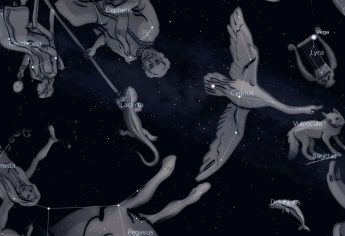This Week’s Sky at a Glance, 2024 Sept 14 – Sept 21
This Week’s Sky at a Glance, 2024 Sept 14 – Sept 21
Salamanders aren’t the most noticeable of critters; you usually have to make an effort to find one. This is a good time to locate the obscure constellation of Lacerta the Lizard, but it will take some effort and a dark sky.
Camouflaged partly by the Milky Way, Lacerta is surrounded by Cepheus, Cassiopeia, Pegasus and Cygnus. A good pointer to it is the base of the Summer Triangle. Running a line from bright Vega to Deneb at the tail of Cygnus and extending it about the same distance puts you near the zigzag shape of the lizard. It is one of those dim constellations created in the late 17th century by Johannes Hevelius to fill in an “empty” section of the sky. At first he named it Stellio; a stellion being a newt with star-like spots found near the Mediterranean Sea. If you manage to catch Lacerta, give yourself a pat on the back and let it go.
This Week in the Solar System
Saturday’s sunrise in Moncton is at 6:56 and sunset will occur at 7:31, giving 12 hours, 35 minutes of daylight (7:02 and 7:36 in Saint John). Next Saturday the Sun will rise at 7:05 and set at 7:17, giving 12 hours, 12 minutes of daylight (7:10 and 7:22 in Saint John).
The Moon is near Saturn on Monday, and Tuesday evening brings a special full moon treat. Not only is it the Harvest Moon, but it is near perigee and a small portion of its northern section passes through the earth’s shadow. This partial lunar eclipse begins at 11:13 pm and lasts for 63 minutes. Early risers with telescopes might want to catch the Moon occulting Neptune Wednesday morning, with the planet disappearing behind the Moon around 5:13 am and reappearing at 5:43. The Moon sets shortly after 6 am so this will be a challenging observation. With the Moon at perigee we will also see extreme tides throughout the midweek. Venus sets an hour after sunset, so catch it in early twilight when it is ten degrees above the horizon. Saturn is now visible all night, being joined by Jupiter after 11 pm and Mars about an hour later. Mercury continues to brighten as it moves toward the Sun, rising 55 minutes before sunrise midweek.
The Sunday Night Astronomy Show resumes this Sunday at 8 pm on the YouTube channel and Facebook page of Astronomy by the Bay.

